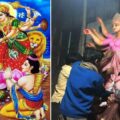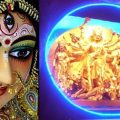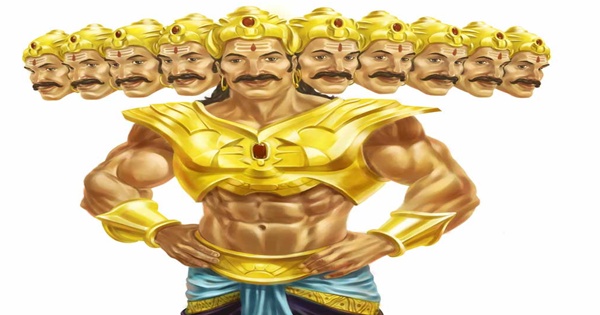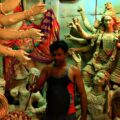Akal Bodhan: Ram’s Invocation of Durga during War against Ravan
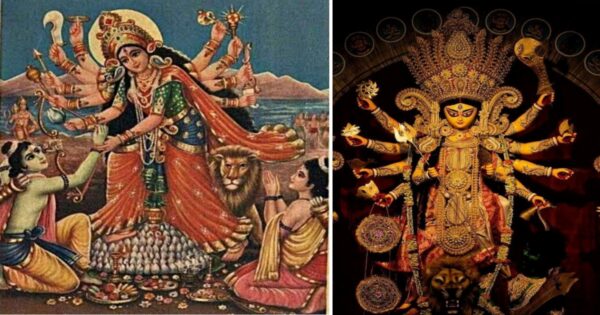
This is depiction of Akal Bodhan – the untimely awakening. While this does not come from the Valmiki Ramayana yet this one incident has had such a powerful impact on the consciousness of the H people that even today the celebration of Durga carries on unabated, and keep growing year after year in this particular period of the year.
The Shakta texts have a nice retelling of this episode. Briefly, as the battle between Rama and Ravana raged on the great goddess of war, Ranachandi/Kali etc. who had been awakened by Brahma, kept watching in mild amusement. Meanwhile seven days of war had been fought and neither party could win. Gods looked down from heaven in wonder and amazement and wished Rama speedy victory. And yet the war went on without a clear end in sight. Only the goddess smiled in amusement. The implication being that Ravana himself was an upasaka of Kali/Chandi – and so long as blessings of the great goddess is on an individual, not even the Visnu Avatara can kill him!
That, as it became clear to Brahma, he immediately approached Rama and proposed that he should worship goddess Chandi/Durga and make her favorable, and only then victory will come. So on the 8th day Rama it is said did the first Durga puja in the battlefield during this phase – earlier durga puja used to be only during the earlier Chaitra Navaratri time (the Navami of which was also Rama’s birthday). Since it was dakshinayana when the gods sleep, so it was awakening the devata in untimely manner – akala (untimely) and udbodhan (awakening), which becomes akal bodhan.
During the puja Rama offer to give 108 lotus flowers to the Goddess. In order to test his devotion, She deliberately removed one lotus from the pack. When it was time to offer the flowers to the goddess, Rama found one less and finding no other option he decided to pluck out his own eyes and make an offering because the texts say that his eyes are padmalocana – or as beautiful as lotuses. Just about when he was going to pluck the eye that the goddess appears and holds his hand and tells him that she was only testing the depth of his devotion. Victory is assured.
And the very next day Ravana, who had held on till now, was dead. This therefore became the origin of the Durgotsava during the Sharad ritu.
Like all spiritual events which leave a deep impact on human world, this too is rich with meaning for a genuine upasaka of Goddess Durga.
1. She manifests most easily during battles. Inner or outer, physical or spiritual. And no battle is raged without her presence in some way or other. Those who are scared of battles, cannot enter into a true sadhana of Durga. And I do not meaning just knowing the puja padhyati, or having some dikshas, no but the actual sadhana with the aim of entering into a communion with the deity.
2. During the course of Durga upasana as one goes closer to the deity, expect the severest of tests to be thrown at the individual. No one, who has not been thoroughly tested, can gain her full blessings.
3. Only those who are pure inside can pass tests for no amount of technical jugglery is enough to cross these barriers. Ravana was a great expert in Devi upasana and the Vedas and his knowledge was without parallel, and yet in that crucial moment his devotion could not match up to the absolute purity of heart and mind that was displayed by avatara of Visnu. That changed the result.
4. Pure is not taking 3 baths a day though that is how it can start. It is eventually taking the consciousness beyond the lower three chakra-s and making sure one does not fall from that state, and one only has a singular devotion towards the deity, without material calculations. Not easy for most, but the goal is clear.
5. The purity is the difference between someone attaining some lower order abilities – siddhis – vs one who gets into the conditions of salokya to sayujya state with the deity. Or, in other words, this is the difference between an average jadu-tona type tantric worshipping Kali vs Sri Ramakrishna Paramhamsa, for there has been no greater upasaka of the Goddess than Ramakrishna in the last 200 years.
6. Ramakrishna attempted to give off his own head to Ma Kali. Rama wanted to pluck out his own eyes as offering. After all the texts have been mastered and all the worship has been done and every sadhana finished across lifetimes there will come that one crucial moment – a leap from the ordinary mentality into the divine state – and there is no formula how to do it, except via anugraha, the deity pulls one into that state and it can only happen via sacrifice. One must sacrifice. From oneself. Something most dear. Without calculations. A statement of absolute commitment – that the whole world is on one side and the deity on another. The physical act of sacrifice is less important, while the perfection of inner commitment is the main thing. It cannot be imitated. Only rarest individuals who have reached that threshold state are capable, and THAT sacrifice is then ACCEPTED by the goddess and a moment of occult miracle happens – which is beyond rational understanding.
7. Since we are neither Rama nor Ramakrishna, and imitation does not work, so we must carry on sadhana in your own limited scope across lifetimes, by the rules framed by texts and acarya-s, so that we attain greater purity, and someday become competent enough to reach the condition where we can sacrifice without calculations of the mind and a powerful alchemy of transformation is triggered – of base metal into gold.
That then is bliss. And it cannot be taught or learned from books. Each one has to rediscover this secret individually.
This article piece is from the Facebook wall (published on 19th October 2023) of Rajarshi Nandy (রাজর্ষি নন্দী), a Sadhaka par excellence and an adherent of the Sanatan Dharma. He is a technical writer by training, and a spiritualist by passion.

